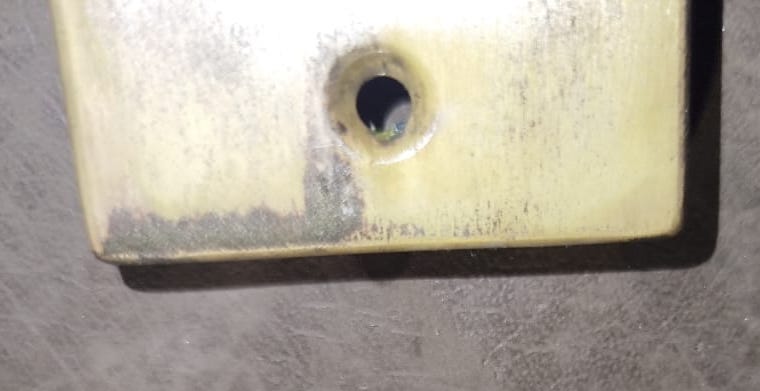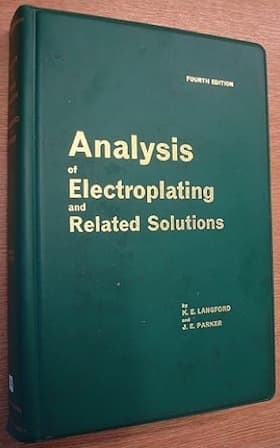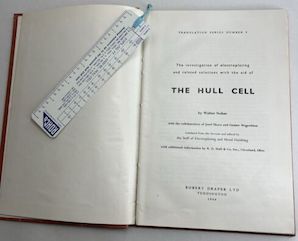
Curated with aloha by
Ted Mooney, P.E. RET

The authoritative public forum
for Metal Finishing 1989-2025

-----
Brass Plating Problems & Issues
[editor appended this entry to this thread which already addresses it in lieu of spawning a duplicative thread]
Q. Hi , I need help please
Why are my brass anodes ⇦ learn moreIn electroplating, the parts to be plated are negatively charged and comprise the cathode; the other half of the circuit is the positively charged anodes. Anodes are usually made of the plating material and dissolve into the solution to provide the necessary metal, although some plating processes use inert anodes which do not dissolve and the necessary metal is added as a metal salt. polarizing?
I did a test on a Hull Cell ⇦ learn moreA standard Hull Cell is a small plating cell, trapezoid-shaped from a top view, with a cathode test panel very close to the anode at one end and very far from it at the other, thus displaying the effect of plating across the whole range of current densities. It is sized at 267 ml for easy math when scaling up from test additions to the cell to additions to the plating tank.
and as time goes by it polarizes ⇦ learn moreWhen current is applied in electroplating, ideally a proportional amount of metal dissolves from the anodes and is deposited onto the parts. But various electrochemical problems can block or partially block this reaction from proceeding properly -- we call those interferences "polarization"., decreasing the current density and increasing the voltage and generating very thin layers of brass.
I attach the latest results of my concentration
CuCN 51.13 g/l
ZnCN 12.22 g/l
CN free 20.5 g/L
I am waiting for your comments and questions, thank you for your attention.
- León, Guanajuato, Mexico.
July 27, 2023
A. Hi Samuel
Although too much cyanide can be a problem, the ASM Metals Handbook "Surface Cleaning, Finishing & Coating" ⇦ this on
eBay,
Amazon,
AbeBooks [affil links]
says that "a slight excess of cyanide is necessary ... to prevent the formation of insoluble zinc and copper salts on the anodes which will stop the flow of current".
Further, Bob Probert mage the suggestion to add cyanide to another plater experiencing anode polarization -- and he was found to be right. So rather than discussing the exact ratio you are using, I think the answer remains as Mr. Probert said: plate some panels in a Hull Cell and "start adding cyanide" :-)
Luck & Regards,

Ted Mooney, P.E. RET
Striving to live Aloha
finishing.com - Pine Beach, New Jersey
Q. For the last 40 years we are doing brass plating --
Silver copper nickel black ... now my brass plating is getting black or tarnishing quickly.
Can you suggest some water base lacquer or some anti-tarnish for good life for brass plating. I'm using Growell products; I have tried many lacquers but it gets colour change or gets black shade sir.
Shop - Mumbai Maharashtra INDIA
October 20, 2023
A. Hi Kiran. Sulfides, such as liver of sulfur
⇦ this on
eBay or
Amazon [affil links]
, are used to darken brass.
If you've been satisfactorily doing brass plating for 40 years, but now the brass turns dark or black, you have to suspect sulfide contamination from new diesel equipment, trucks running at the loading dock, or some other change which has introduced a lot of sulfide into the area.
As far as deterring tarnish, the first step is probably a dip in a proprietary benzotriazole
⇦ this on
eBay
or
Amazon [affil links]
or similar solution, before the application of the lacquer. Some clear coats and brass lacquers like Incralac
⇦ this on
eBay or
Amazon [affil links]
include benzotriazole in their formulation.
Luck & Regards,

Ted Mooney, P.E. RET
Striving to live Aloha
finishing.com - Pine Beach, New Jersey
Q. Hi
I bought a new brass salt when I electroplated the part with this salt brown lines appears at some places during electroplating although remaining part color is ok. What is the reason. I do bright nickel before brass plating
Electroplater - Lahore Pakistan
March 20, 2025
Q. Hi. We have purchased new brass salt; the problem is when we electroplate the brass it forms brown lines in some areas of the parts and other areas color are okay ... what is this problem?

Shop employee - Lahore Punjab
March 21, 2025
A. Hi Waseem.
Sorry to have to say this Waseem, but that plating is horrible. The supplier of that brass salt should be helping you to solve this problem.
Can you give us some additional details please? Are you an established brass plater and this problem suddenly popped up when you bought some new brass salt, or is this a new installation and you haven't done satisfactory brass plating yet?
Is the substrate plain steel? Is there copper plating under the brass plating or are you plating brass directly on the substrate? What is your pretreatment sequence? Do you know how long you plate and how thick the brass plating measures? Do you have a Hull Cell ⇦ learn moreA standard Hull Cell is a small plating cell, trapezoid-shaped from a top view, with a cathode test panel very close to the anode at one end and very far from it at the other, thus displaying the effect of plating across the whole range of current densities. It is sized at 267 ml for easy math when scaling up from test additions to the cell to additions to the plating tank. so that you can plate clean brass or steel panels and see how they come out?
Unfortunately, I think you are very far from successful plating :-(
Luck & Regards,

Ted Mooney, P.E. RET
Striving to live Aloha
finishing.com - Pine Beach, New Jersey
Q. Yes I'm a brass plater. The problem arose when we bought new brass salt. The base metal is mild steel and and we do bright nickel plating before brass; and our pre-treatment is as follows: ultra sonic cleaning, acid etching, electrolyic degreasing, acid activation, nickel plating, acid activation and brass plating. Each step is followed by proper rinsing with RO water.
Waseem jaferShop employee - Lahore Punjab
March 22, 2025
A. Hi again.
The circumstances point towards the problem being defective plating salts, as you say ...
... but unless the photo is playing tricks on me, it looks like an area of no plating at all, and extremely thin very porous plating.
What you are calling a brown line, looks to me like no plating at all on the left bottom edge of the part, either due ro it being stripped, or not clean and remaining unplated.
Three things I can suggest besides replacing the brass plating bath would be:
• running a clean Hull Cell panel
• scrubbing a few test parts with pumice before putting them through your plating cycle
• pulling a few parts out after nickel plating and examining them.
Hopefully another brass plater will chime in with some insights.
Luck & Regards,

Ted Mooney, P.E. RET
Striving to live Aloha
finishing.com - Pine Beach, New Jersey
⇩ Related postings, oldest first ⇩
Abnormal consumption of sodium cyanide
Q. I have a problem with our Brass Plating Solution. There is abnormal consumption of NaCN even without production (i.e. 12 g/l to 10.5 g/l). At first, I thought we had wrong chemical analysis but I was proven wrong since analyses of the other components are correct. Some say that the NaCN reacts with the Brass Anode; some say formation of oxides on the Anode. I would like to solicit technical help from everyone. By the way, the Brass solution is used to plate copper foils running at 26.5 m/min.
Ferdinand U. Collado- Sta. Rosa, Laguna, Philippines
2001
A. Is there a possibility that you are dragging in acid (which kills the cyanide) from your pretreatment?
Joel Tomasetti- Petersburg, Virginia
![]() Thanks Joel for taking interest in my query. But we have several Pure water rinses after the acid dip prior to Brass Plating.
Thanks Joel for taking interest in my query. But we have several Pure water rinses after the acid dip prior to Brass Plating.
- Sta. Rosa , Laguna, Philippines
A. Ferdinand,
I have been servicing and analyzing brass plating solutions for over 30 years. There are many possible reasons for high use of cyanide salts. Firstly, is the cyanide being broken down into sodium carbonate (analytical procedure available in many reference books)? If so, check the solution temperature and agitation. Either can accelerate the breakdown of the free sodium cyanide to form sodium carbonate and hydrogen gas. Another source of this problem is operation at high current densities where large amounts of hydrogen are evolved at the anode.
Gene Packmanprocess supplier - Great Neck, New York
![]() Gene,
Gene,
I think you have some points. First, we circulate the 9.5 cu. meter brass solution constantly even without operation. We also maintain the solution temperature at 77 °C. We also use high current at 7.7 A/dm2 because of the continuous plating nature of Copper Foil. Thanks a lot, and we will consider your inputs in our discussions.
Ferdinand U. Collado [returning]- Sta. Rosa , Laguna, Philippines
A. The temperature seems a bit high on the tank this would cause the cyanide to break down quicker than may be expected.
Is it possible to turn off the heating when not in use and then turn on in time for the tank to be ready for production?

Martin Trigg-Hogarth
surface treatment shop - Stroud, Glos, England
How to analyze free cyanide in brass plating solution?
Q. Gene,
I understand that you have a lot of experience with brass. I have difficulties analysing the free cyanide in brass. Do you have an analysis process that is really working? If positive I will appreciate of you could publish it (the method mentioned in the Metal Finishing guide works only for a new solution).

Sara Michaeli
Tel-Aviv-Yafo, Israel
2001
by Langford & Parker

on Abebooks
or Amazon
(UTL on eBay)
(affil links)
A. Hi Sara,
Langford and Parker [on AbeBooks or eBay or Amazon affil links] , says 10 ml sample, 150 ml water and 2 ml of 10% KI. Titrate slowly to prevent premature end point. I believe that I used to titrate without the KI until the first turbidity, only then adding the KI. I don't remember if it was for cyanide analysis, but maybe it will improve reproducibility.
I don't remember having trouble with the analysis. What problems are you having?
Regards,

Tom Pullizzi
Falls Township, Pennsylvania
![]() Hi Tom,
Hi Tom,
Thanks for your reply.
My problem with the cyanide is not with the end point (which is clear), the point is that when you add a known amount of cyanide to the tested solution and you titrate it again, you find out that the result is not accurate.

Sara Michaeli
Tel-Aviv-Yafo, Israel
A. Sara,
I think cyanide analysis is always free cyanide, so if you add cyanide and make a analysis I expect that the results are lower than the value you added. This is because of the cyanide forming complexes. If you use always the exact same analysis method you should get values that are usable in the control of your baths.
Regards,
Marcus Hahn- Sachseln, Switzerland
Q. I make ancient clocks as a hobby and I am looking for a formula for a non cyanide solution for the plating in brass of very tiny parts (they are too small & delicate for barrel plating and the local blokes can't do them.) I only need to make about 1 to 2 liters of the solution. I believe there may be an acidic solution but I may be wrong. Any help would be very highly welcome.
Ron Collins- Ballarat, Vic, Australia
2003
A. REF a book-not tried:
CuSO4-40-55 G/L
ZnSO4-35-55 G/L
ROCHELLE SALT
⇦ this on
eBay
or
Amazon [affil links]
380-420 G/G
NaOH 80-100 G/L
T=45-50 °C,1-1.5 A/sqdm, good air agitation
OR
Na6Cu(P207)-4G/L
Na6Zn(P207)-12G/L
NaP2O7-11G/L
Na2HPO4-18G/L
T=40 °C/1.25-2A/sqdm
Good luck

Khair Shishani
aircraft maintenance - Al Ain, UAE
2004
Can potassium cyanide be used in brass plating bath?
Q. Hi, I need help.
Can I use a KCN in brass to make up a new bath??
- GDL, Mexico
May 25, 2013
A. Yes, but then you cannot freeze out the carbonates.

Robert H Probert
Robert H Probert Technical Services
Garner, North Carolina

Ed. note: Robert is right that potassium carbonate will be soluble and not amenable to freezing out. For a detailed discussion of freezing, and carbonate removal from cyanide plating solutions, etc., please see thread 0473.
Blue tinge at corners of brass plating
Q. When I do brass plating I experience a bluish tinge at the corner surface areas.

Kindly suggest a remedy.
amish gala- mumbai India
August 27, 2014
A. Dear Amish Gala,
Hi.
Firstly, for bright Brass, we usually use bright nickel as base coat and then a thin film of brass. This thin film can be achieved by low cyanide baths or Medium cyanide in short time, but the low cyanide is much better. As the thin film is too sensitive and active in electroplating polluted air and oxidizes soon, so you can seal it by using 20-30 gr/lit sodium or potassium dichromate in DIW with pH between 6 to 7. (I mean the pH of water). Deep in this solution for 5-10 seconds, rinse twice and let it dry. You won't see the blue parts at edges.
Good Luck

Alireza Reyhan
- Istanbul, Turkey
September 3, 2017
Brass anodes are polarized
Q. What is causing my brass anodes in my cyanide brass bath to polarize ⇦ learn moreWhen current is applied in electroplating, ideally a proportional amount of metal dissolves from the anodes and is deposited onto the parts. But various electrochemical problems can block or partially block this reaction from proceeding properly -- we call those interferences "polarization".?
John StambaughRestorer - Abbottstown, Pennsylvania
April 18, 2019
by Larry Durney

on eBay
(sometimes) or
AbeBooks
(rarely)
or Amazon
(sometimes)
(affil links)
A. Hi John. You've posted here over the years, and you are apparently an experienced brass plater who has been plating satisfactorily, rather than someone who has never done it before. As Durney notes, that means something has changed that you haven't accounted for yet. One possibility that occurs to me (why it's a problem is explained by Fred Mueller in thread 4620), is that maybe you started plating larger parts such that your anode to cathode ratio decreased and the anodes are therefore oxidizing?
Regards,

Ted Mooney, P.E. RET
Striving to live Aloha
finishing.com - Pine Beach, New Jersey
A. Try what Ted said first, of no help, then go into the Hull Cell and start adding cyanide.

Robert H Probert
Robert H Probert Technical Services
Garner, North Carolina

A. Hi John,
What worked for me years ago, was mixing up the brass anodes with equal area of graphite anodes.
By physical observation I could see the evolution of O2 reduce and the anodes worked fine and didn't go passive. The metal content stayed level where I wanted.
All the best :)

Khozem Vahaanwala
Saify Ind
Bengaluru, India

![]() I went into the hull cell and added more cyanide. Thanks to your help! This eliminated the polarized anode problem.
I went into the hull cell and added more cyanide. Thanks to your help! This eliminated the polarized anode problem.
The bath has been performing well.. Thanks!
John
Brasswheel Polishing - Abbottstown, Pennsylvania USA
Q. Hi my name is Eddie; I've got problems with the final color of Gold on yellow Brass (I got a little pink). I understand that the redness is caused by a lack of ammonia ⇦ this on eBay or Amazon [affil links] and I have to control the pH between 10.10 to 10.30. Any suggestion?
Eddie Vargasplating - Miami, Florida
August 19, 2019
![]() "I understand that the redness is caused by a lack of ammonia and I have to control the pH between 10.10 to 10.30. Any suggestion?"
"I understand that the redness is caused by a lack of ammonia and I have to control the pH between 10.10 to 10.30. Any suggestion?"
You already have the answer. Add a little ammonia and control the pH.

Jeffrey Holmes, CEF
Spartanburg, South Carolina
Q. Hello, I have a new plating shop, I have a bright nickel bath and a brass bath
My brass bath is not working; it's a new mix, I've got this formula for a golden color:
- 67 g/l of sodium cyanide
- 28 g/l of copper cyanide
- 8 g/l of zinc cyanide
- 30 g/l of ammonium chloride
- 14 g/l of sodium carbonate
The bath temperature is around 20 °C and I tried it with 3V to 6V current --
... the result is a silver color just like the color of the bright nickel, so either there is no deposition or it's just zinc.
Please help me I am confused. What is wrong with this bath?
Thanks in advance.
- Algiers Algeria
January 29, 2021
A. Yes that's nickel undercoat only because the cyanide content is almost double.
Ashok Maharana- Mumbai, India
July 17, 2023
Q. Hi. I am having problems in brass plating, i.e., redness in center of plate. Also the solution turned greenish. Also, while adding salt there is no increase in zinc content after analysis.
What might be the reason for greenish solution and anode looks like copper.
CHEMIST - UAE
April 6, 2022
A. Hi Syed. It seems to me that the most important clue in your description is that you say you are adding zinc salt and having no increase in zinc content. Perhaps I'm misunderstanding you because that is simply not possible :-)
Either your analysis procedure does not work, or the salt which you are adding is not zinc salt. Has your supplier analyzed the bath? Have you plated any Hull Cell panels? Is it remotely possible that you are adding a nickel salt or some other salt when you think you are adding zinc?
Luck & Regards,

Ted Mooney, P.E. RET
Striving to live Aloha
finishing.com - Pine Beach, New Jersey
Q. WE MAKE OBJECTS FOR LEATHER GOODS IN BRIGHT BRASS AFTER NICKEL PLATING, A BRASS FLASH IS GIVEN. THE PROBLEM IS THAT THE BRASS FALLS OFF IN SOME AREAS AND IT IS NOT IN ALL THE PIECES. WHAT COULD BE THE REASON IF THE RINSES ARE CLEAN?
SAMUEL PEREZEMPLOYED PLATINUM - GUANJUATO, MEXICO
October 4, 2022
A. Hi SAMUEL. Nickel passivates quite quickly. Get some test parts from the nickel tank to the brass tank as quickly as you can consistent with proper rinsing and see if the adhesion problem goes away on that batch.
Luck & Regards,

Ted Mooney, P.E. RET
Striving to live Aloha
finishing.com - Pine Beach, New Jersey
Q, A, or Comment on THIS thread -or- Start a NEW Thread

